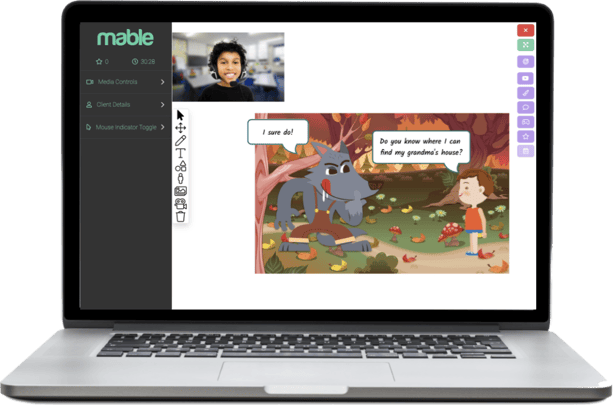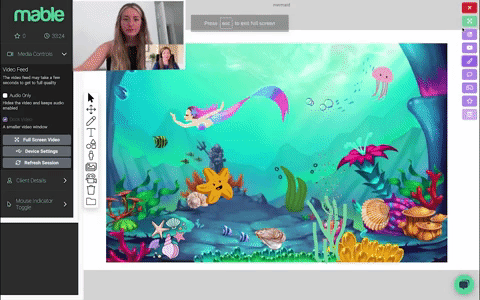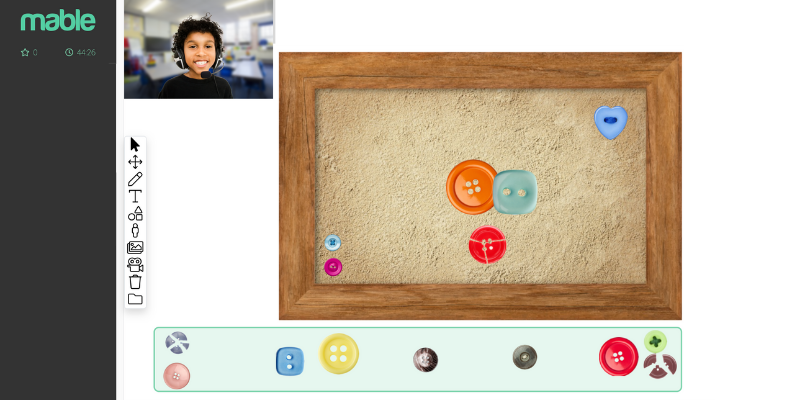Using stories and fairy tales in children and young people’s therapy

Contents
Stories, fairy tales, myths, legends, and fables have been used for centuries to teach, inspire, guide, and enrich our lives. They can speak to us on a far more profound, more immediate level than everyday language, helping us understand ourselves and others better. They help us view situations from a different perspective, develop empathy and compassion, resolve problems, and come up with different solutions. Stories can give us a sense of hope and optimism, help us to appreciate and respect different values and beliefs, and positively influence our social behaviour.
I use stories regularly in my work as a counsellor. At Mable, I’m able to use the canvas’ creative software, giving me and the child limitless opportunities to create new worlds and tell stories to make sense of their experiences.
Why do we use creative therapeutic storytelling in children’s counselling?
Children have an innate love of stories; they’re magical and create a sense of wonder, so using stories can captivate the child and help them engage in their therapy. Using stories in therapy stimulates the imagination and allows the child to explore and solve personal and social problems, giving them skills to apply to their real lives.
Sometimes the communication between adults and children can feel misaligned. An adult’s directness can often lead to the child feeling lectured or told off, and children also tend to switch off when they are faced with lots of questions. They respond better to a commentary or narrative style of communication. Their natural 'language of feeling' is that of images and metaphor as in stories and dreams. The language adults use can sometimes clash with this and compresses the child’s emotional experience, leading to them feeling misunderstood and isolated.
Often children will try to avoid talking directly about their difficult feelings or lived experiences. A therapeutic story is a more empathic and less invasive way of accessing the child’s inner experience. They don’t have advanced coping strategies to manage complex and intense feelings or the inner resources for thinking them through and regulating their emotional arousal. Children and young people need help to fully process their experiences, thoughts and feelings; otherwise, the emotional overwhelm will lead to them ‘behaving’ these difficult emotions. Often this will present in psychological conditions such as anxiety, obsessions, hyperactivity, phobias, bed-wetting, fear and unhappiness, aggression, learning difficulties, rituals, and nightmares.

How does using stories work?
Through the construction of new stories or recreating well known and loved fairy tales, working in the metaphor enables the child to explore a similar narrative to their lived experience from a safe distance. In effect, they’re working from the third person. It normalises their experience, making it seem less frightening and less isolating. The child can understand and link the challenges that the character in the story faces, to their own. It enables them to view the situation from a wider perspective, thus developing empathy and self-compassion.
Stories give children hope that they can and will overcome challenges in their lives. They help children to consider new ideas and experiment with their dilemmas from a safe distance in a solution-focused way. They can try out different responses, approaches, and endings without fear of failure. The concept of being helped is encouraged and supported through cooperation and participation with the therapist and characters in the story.
Using creative software for storytelling
Before I started at Mable, I thought creative therapy would be much trickier when working online compared with face-to-face. The number of physical resources I was using in my counselling room would be hard to replicate. Once I started, I realised that the online shared platform gave us a world of creative possibilities, and it engaged the children using their favourite medium – technology! Here are some of the ways I use the Mable Canvas:
1. Using GIFs and Background Scenes
Some younger children find it hard to use traditional therapy methods as they lack the concentration levels to focus or sit still, so using moving animated graphic images brings the canvas to life in a fun, interactive way. When the child is excited and happy, dopamine and endorphins are released which help reduce their stress levels. This means the child is relaxed and willing to access and communicate their inner thoughts, whilst feeling safe and emotionally held.
Children will often recreate common themes and difficulties they are going through in their story and then try to make sense of it with the help of the counsellor. Using role-play, the child can embody each of the characters, in turn, expressing themselves through different perspectives. This helps them develop a new narrative and wider perspective, whilst simultaneously processing what’s happened.
A young client of mine recently recreated a scene from The Little Mermaid. Using a seabed background, she brought it to life adding a variety of chosen GIF characters and then recreated her own story narrative through the moving seascape. She became each of the characters in turn and was thrilled with her creation. We were able to explore some recurring themes for her in a sensitive manner and her parent later commented on how powerful the session had been for her. Better still, in the next session, she asked to return to her story to adapt and make changes, demonstrating that she’d moved forward with how she was processing the world.

2. Storyboarding & comic strips
Using storyboarding and comic strips in therapy gives the child the flexibility to explore and try out different endings, experiment with their own feelings and responses as well as those of other characters. It also enables serious topics to be brought to life, worked through, and re-enacted at the child’s own pace. This allows them to feel safe and in control whilst developing their autonomy.
Using a storyboard structure, the child can create their own story version or adapt and improvise it. The characters can be drawn freehand using the drawing software or by selecting an image from the Canvas’ picture library. These images can be resized and repositioned, and text boxes or thought bubbles can be used to add dialogue, all of which give the child power over the story. This activity allows the child to express their feelings through verbalising what the characters may say, which helps them sense how these words will be interpreted and perceived.
3. Using emojis & text chat
Often children do not have the words to say or explain how they feel, or the confidence to share their innermost feelings. They will often try to change the subject, distract, or respond with ‘I don’t know or ‘not now’ when adults try to discuss difficult conversations with them.
Several of my young clients use the text chat feature when they want me to know something important but feel unable to say it out loud. Quite often the child will say they’re okay, but then type their real feelings into the text box. This feature helps children communicate the ‘unsayable’ in a subtle but powerful way. The use of emojis complements this. Sometimes the question ‘how are you feeling?’ will be met with the stock response of ‘fine’, but ask them to choose an emoji to represent their feelings and they’re much more able to express what they’re going through.
4. Mooli Lahad’s Six-Part Story Method (SPSM)
Created by psychologist Mooli Lahad, this six-part, solution-focused story structure encourages creative expression through art. Lahad suggests the child’s unconscious mind communicates their thoughts and worries through the images they create. The child is asked to draw: the main character of a hero, a mission or goal the character must achieve, resources and people who can help, and obstacles that stand in the way. They’re finally asked to draw how the hero overcomes this obstacle and how the story ends.
Usually, the child embeds their own experience or common themes within the story, whilst still working in the metaphor. This then opens the way for therapeutic discussion. SPSM enables the child to face their challenges head-on, recognise their own strengths, visualise their own coping mechanisms and identify different strategies and solutions to a problem, which are all important life skills.
5. Using the Canvas sand trays

Working with stories and metaphors enables children to explore their thoughts and feelings in a psychologically safe way, without the defensiveness that often occurs when we’re asked to open up about difficult issues. During the pandemic, many children’s counsellors were at a loss as to how to transfer their creative work to the virtual world. Working at Mable, I felt lucky that I didn’t have that issue and was able to do some really creative story work using the canvas, at a time when my clients really needed it.
If you would like to hear more about our children's counselling service, then please get in touch.